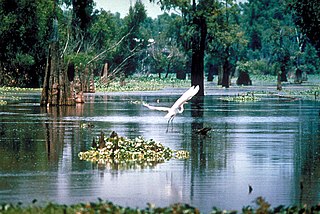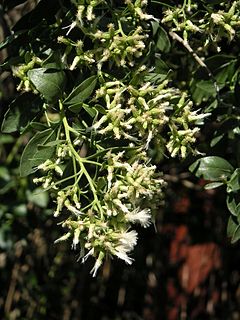
A salt marsh or saltmarsh, also known as a coastal salt marsh or a tidal marsh, is a coastal ecosystem in the upper coastal intertidal zone between land and open saltwater or brackish water that is regularly flooded by the tides. It is dominated by dense stands of salt-tolerant plants such as herbs, grasses, or low shrubs. These plants are terrestrial in origin and are essential to the stability of the salt marsh in trapping and binding sediments. Salt marshes play a large role in the aquatic food web and the delivery of nutrients to coastal waters. They also support terrestrial animals and provide coastal protection.

The wetlands of Louisiana are water-saturated coastal and swamp regions of southern Louisiana.

The western pygmy blue is one of the smallest butterflies in the world and the smallest in North America. It has reached Hawaii, as well as the Persian Gulf, including eastern Saudi Arabia, Bahrain and the United Arab Emirates. The upperside is copper brown with dull blue at the bases of both wings. The underside of the hindwing is copper brown with white at the base; the fringe mostly white, with 3 small black spots near base, and a row of black spots at outer margin. The wingspan is 12 - 20 mm. Life History: Males patrol over the host plants all day to find receptive females. Females lay eggs all over the host but particularly on the uppersides of leaves. Caterpillars eat all parts of the plant. Chrysalids hibernate. Flight: July-September in the north, all year in South Texas. Caterpillar Hosts: Pigweed, saltbush species (Atriplex), and others in the goosefoot family (Chenopodiaceae). Adult Food: Flower nectar. Habitat: Alkaline areas such as deserts, salt marshes, and wasteland. Range: Common. Central California east to southern Nevada, central Arizona, central New Mexico, and west Texas. South through southern California, Baja California, and Mexico to Venezuela. Migrates to Arkansas, Nebraska, and Oregon. United Arab Emirates, Bahrain, eastern Saudi Arabia along the Persian Gulf coast up to Kuwait.
Sesarma reticulatum, the purple marsh crab or simply marsh crab, is a crab species native to the salt marshes of the eastern United States.

Baccharis halimifolia is a North American species of shrubs in the daisy family. It is native to Nova Scotia, the eastern and southern United States, eastern Mexico, the Bahamas, and Cuba.

Solidago sempervirens, the seaside goldenrod or salt-marsh goldenrod, is a plant species in the genus Solidago of the Asteraceae family. It is native to eastern North America and parts of the Caribbean. It is an introduced species in the Great Lakes region and the Azores.

Tarpons are large air-breathing fish of the genus Megalops; one species is native to the Atlantic, and the other to the Indo-Pacific Seas. They are the only members of the family Megalopidae.
Maritrema heardi is a parasitic fluke that infects the marsh rice rat in a salt marsh at Cedar Key, Florida. It was first listed as Maritrema sp. II in 1988, then described as the only species of a new genus, Floridatrema heardi, in 1994, and eventually reassigned in 2003 to Maritrema as Maritrema heardi. Its intermediate host is the fiddler crab Uca pigilator and it lives in the intestine of the marsh rice rat, its definitive host. Together with two other species of Maritrema, it is very common in affected marsh rice rats; it infects 19% of studied rats at Cedar Key. According to Tkach and colleagues, M. heardi is probably primarily a parasite of birds that has secondarily infected the marsh rice rat. Floridatrema was distinguished from Maritrema on the basis of its possession of loops of the uterus that extend forward to the place where the intestine is forked or even to the pharynx. Genetically, M. heardi may be closest to the morphologically similar M. neomi, which infects Neomys water shrews in the Carpathians.
Ascocotyle pindoramensis is a fluke in the genus Ascocotyle that occurs along the eastern coast of the Americas from Brazil to Nicaragua, Mexico, Louisiana, and Florida and doubtfully in Egypt. It occurs in the intestine of its definitive hosts. Hosts recorded in the wild include the least bittern, roseate spoonbill, great blue heron, striated heron, stripe-backed bittern, yellow-crowned night heron, black-crowned night heron, osprey, Neotropic cormorant, and marsh rice rat. In the marsh rice rat, it infected 9% of rats examined in a 1970–1972 study in the salt marsh at Cedar Key, Florida, but none in a freshwater marsh. A. pindoramensis has been experimentally introduced into the domestic duck, chicken, dog, house mouse, and golden hamster. It occurs in various body parts of its intermediate hosts—the poeciliid fish Phalloptychus januarius, Poecilia catemaconis, Poecilia mexicana, Poecilia mollienisicola, Poecilia vivipara, and a species of Xiphophorus and the cichlid Tilapia. It was first described as Pygidiopsis pindoramensis in 1928 and subsequently as Pseudoascocotyle mollienisicola in 1960. The latter species was moved to Ascocotyle in 1963, but only in 2006 it was recognized that the two represent the same species, which is now known as Ascocotyle pindoramensis. Other flukes from Argentina and Mexico that were identified as Pygidiopsis pindoramensis instead represent a different species of Pygidiopsis.
Maritrema prosthometra is a parasitic fluke from North America. It was first described in 1969 from the intestine of the clapper rail in eastern North America. Later, it was also found in the small intestine of 5% of a sample of marsh rice rats collected in a salt marsh at Cedar Key, Florida, where it used the fiddler crab Uca pigilator as an intermediate host.
Maritrema is a genus of trematodes (flukes) in the family Microphallidae, although some have suggested its placement in the separate family Maritrematidae. It was first described by Nikoll in 1907 from birds in Britain. Species of the genus usually infect birds, but several have switched hosts and are found in mammals, such as the marsh rice rat. Several species use the fiddler crab Uca pigilator as an intermediate host.
Acanthotrema cursitans is a species of fluke in the genus Acanthotrema. It infects the marsh rice rat Oryzomys palustris, the raccoon Procyon lotor, the Virginia opossum Didelphis virginiana, the snail Cerithidea scalariformis, and killifishes of the genus Fundulus on the Gulf Coast of Florida. It was first described as Cercaria cursitans in 1961, the moved to Stictodora in 1974, and to Acanthotrema in 2003.

Spartina patens, the saltmeadow cordgrass, also known as salt hay, is a species of cordgrass native to the Atlantic coast of the Americas, from Newfoundland south along the eastern United States to the Caribbean and northeast Mexico. It has been reclassified as Sporobolus pumilus after a taxonomic revision in 2014, but Spartina patens is still in common usage. It can be found in marshlands in other areas of the world as an introduced species and often a harmful noxious weed or invasive species.
Homalometron pallidum is a species of marine trematodes in the family Apocreadiidae. It is an endoparasite of the mummichog, Fundulus heteroclitus, a small fish found in brackish water along the east coast of the United States and Canada. It has a complex life cycle and lives inside several different host species at different stages.

Iva frutescens is a species of flowering plant in the aster family known by the common names Jesuit's bark, bigleaf marsh-elder, and high-tide bush. It grows in coastal eastern North America from Nova Scotia down the eastern coast and along the Gulf Coast to Texas.
Nerodia clarkii clarkii, the Gulf salt marsh snake, is a subspecies of N. clarkii that is indigenous to the southeastern United States. It is a nonvenomous, colubrid snake that inhabits coastal salt marshes and brackish estuaries along the coast of the Gulf of Mexico from Florida to Texas.

Borrichia frutescens is a North American species of flowering plants in the aster family known by the common names sea oxeye, sea oxeye daisy, bushy seaside tansy, and sea-marigold. In Veracruz it is called verdolaga de mar. It is native to the United States and Mexico, where it occurs along the Atlantic and Gulf Coasts. Its distribution extends from Maryland south to Florida and west to Texas in the US, and along the Mexican Gulf Coast to the Yucatán Peninsula. It is an introduced species in some areas, such as Bermuda and Spain.
Coastal Erosion in Louisiana is the process of steady depletion of wetlands along the state's coastline in marshes, swamps, and barrier islands, particularly affecting the alluvial basin surrounding the mouth of the Mississippi River at the foot of the Gulf of Mexico on the Eastern half of the state's coast. In the last century, Southeast Louisiana has lost a large portion of its wetlands and is expected to lose more in the coming years, with some estimates claiming wetland losses equivalent to up to 1 football field per hour. One consequence of coastal erosion is an increased vulnerability to hurricane storm surges, which affects the New Orleans metropolitan area and other communities in the region. The state has outlined a comprehensive master plan for coastal restoration and has begun to implement various restoration projects such as fresh water diversions, however certain zones will have to be prioritized and targeted for restoration efforts, as it is unlikely that all depleted wetlands can be rehabilitated.
Acanthotrema is a genus of trematodes in the family Heterophyidae.











